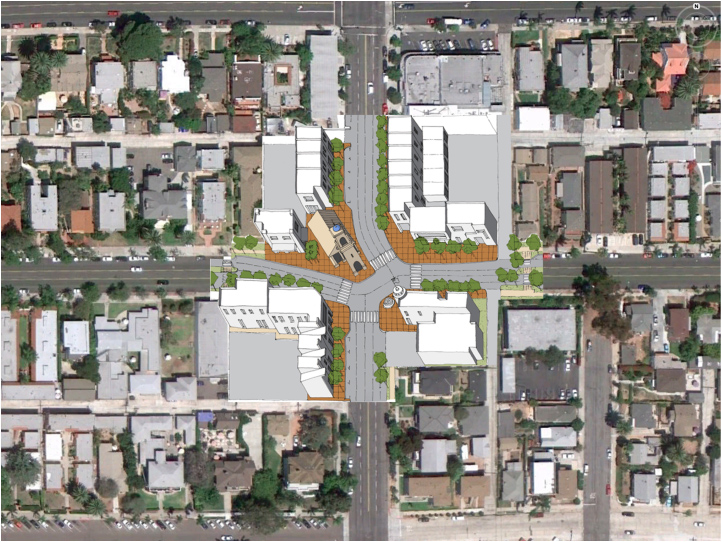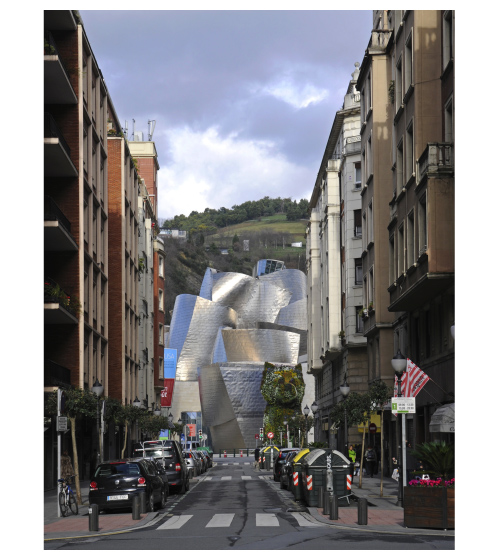A Placemaking Journal
Coding for Character: The Architecture of Community
My career as an urban designer has been spent, not surprisingly, doing what urban designers do: crafting plans and regulations for municipalities to build great places. A side effect of this, much to my wonderful wife’s chagrin, is that whenever we travel I remain ‘on the job,’ annoyingly interrupting her shopping with some variation of: “Would you look at that terminated vista!”
She walks away as I take 37 pictures of “the enclosure!”
We willingly pay thousands of dollars to travel long distances to soak in the ‘character’ of wonderful places. My wife intuitively knows that the shopping will rarely disappoint, and I know that these places are invigorating, inspiring and flat out illegal to build in my home town.
“Americans can drive from one ocean to the other, stopping every day for the same hamburger and every evening at the same hotel, as traveling in a straight line is no longer much different than traveling in a circle.” – Dan Gilbert

The roads to Sedona, Taos, Kona or just about anywhere else are paved with supercenters, office parks, and vacant strip malls. Placeless places whose future relevance rests on our ability to wrangle redevelopment, formerly vilified as urban renewal, in service of somewhat smarter outcomes.
But newsflash: Redevelopment is just about dead. Here in California, the Governor is raiding local redevelopment coffers to balance this year’s budget. And yet, at the local level, we continue to hang onto redevelopment’s past slash-and-burn approach to generate tax revenue to keep the lights on, fill potholes, and keep pension plans funded.
Let’s be honest. Our cities are broke and redevelopment was unpredictable at best — except in causing a lot of angst among the general public. And, despite Einstein’s definition of insanity, a majority of our nation’s Planning Departments have stubbornly continued to use the same Land Use-based planning tools over and over again, expecting different outcomes. These same municipalities have also separated placemaking responsibilities: Public Works regulates streets; Park & Rec regulates civic spaces; General Services builds civic buildings; and now, with planning departments being cut across the nation, it appears Code Enforcement will be regulating private development.
It is time to bring out a new set of tools to help our cities grow more strategically in our new economy and re-focus new development to contribute towards a sense-of-place that is socially, culturally and economically valuable.

1. ITS A NEW CENTURY, GO AHEAD AND USE NEW TOOLS
The rise of Form-Based Codes, from Denver to Miami, is an obvious 21st-Century planning tool that needs to be embraced by every municipality across the nation. To stop building sprawl, and start building urbanism, we need these urban-to-rural, place-based planning tools.

2. PLAN FOR THE COMPLEXITY OF NEIGHBORHOODS
Urban Design Mystic, Leon Krier, defined the following basic elements of community. First, the city’s Public Realm is made up of Foreground / civic buildings and civic spaces (streets / churches / parks / libraries), and that the Private Realm consist of Background / privately owned buildings and spaces (houses, offices, shops). These realms are inter-dependent and shape our neighborhoods and towns. Neighborhoods are where we live, and they are filled with people and places that provides for our daily need to be healthy, social, and spiritual.

3. UNDERSTAND THE COMPLEXITY OF URBAN PATTERNS
Second, the structure of the neighborhood’s pattern of streets, blocks, squares, plazas, parks, is either less formal / ordered, organic (the language of specific place, or Vernacular) or more formal / ordered (Classical), or a combination of both. The English Village is Organic; the American Grid is formal / classical; and Madrid’s Plaza Mayor combines both elements with a classical foreground civic plaza and a more organic background of private streets and blocks.

4. UNDERSTAND THE COMPLEXITY OF ARCHITECTURE
Thirdly, Krier found that the character of the Architecture is also either less formal / ordered (Vernacular) or more formal / ordered (Classical). That means the buildings are of either a very simple vernacular or a very formal classical character.
5. UNDERSTAND THE CLASSIFICATION OF YOUR COMMUNITY’S CHARACTER

These elements allow us to begin studying Three-Dimensional patterns of great places (as well as boring places) through a legible pattern that blends the urban and architectural background/foreground elements with formal and informal elements to identify unique characteristics of each place. The image above is of the elements that regulate Santa Fe’s distinctive character.
The study below identifies 16 general community character types. Ranging from the naturalistic Taos Pueblo to Beijing’s oppressively ordered Forbidden City, this 16 character type analysis assists in understanding existing places and to plan for new places.

6. WORK WITH LOCALS TO UNDERSTAND VALUES AND NEEDS

It also appears that this place-less-ness has freaked people out, and how we talk to each other has suffered for it. Propose a new development and people will be falling out of trees to oppose it. In really nice places, they’ll oppose it for fear that it will lessen their property values; where there is no “there there,” they’ll oppose it fearing the next development will get something more than they got. As urban design professionals, we need to explain our principles and foster an inclusive, localized public process built first around the identification of ‘character,’ rather than responding to or negotiating with developer proposals after the fact. Call it “Fair Trade Placemaking.”

7. FUND NEW DEVELOPMENT IN LAND RATHER THAN CONDEMNATION
The old redevelopment model pays fair market value, assembling and clearing a full block of private properties. It puts the pressure on the fronts of all surrounding buildings, increasing the potential number of angry neighbors who don’t want to participate.
But consider this:

This is a new model that reconfigures redevelopment from one based entirely on private parcels to one built around the creation of civic centers. Using city land, it reconfigures large, formal intersections into an informal Urban Pattern that terminates the street view from four ways. This new approach makes conflicts with new development happen mid-block, backs on backs, and focuses change on creating complex public and private places. Rather than using condemnation, the city actually has skin in the game by putting land into the deal, and reconfigures overly-wide streets and setbacks at the intersection to balance the needs of pedestrians, bikes, transit and cars.
This idea is intended to solve for infill development over the next ten years as we move out of this Great Recession. It is not intended for every intersection but is ideal for neighborhood and regional centers typically identified in city plans as ‘Commercial or Mixed-Use Nodes.’ In addition, these are usually located at Transit Stops and Stations on Transit Authorities. Usually, street improvements come from a city’s General Funds, rather than an earmark allocated to a specialized department, or Tax Increment Funds. Transit Authorities have State and Federal funding access to redevelop important sites throughout a region.
CASE STUDY – MY LOCAL NEIGHBORHOOD

My neighborhood is a mostly forgettable but orderly grid of overly-wide streets with pawn shops and taco shops behind parking lots. The surrounding architecture is eclectic, informal modernist boxes. However, being adjacent to San Diego’s Balboa Park, there is a precedent for Classical and ordered architecture in the area.

The Commercial Node is transformed into a civic space, instead of an intersection, making it a textbook American Square, set in the neighborhood’s best location, right in the center! The informal foreground urban pattern is in contrast to the formal urban background pattern, which creates a civic and mixed-use destination within the neighborhood that will capture trips as well as generate/receive trips. The Square is complex, with a transit plaza, paseos, sidewalk dining, fountains, and crosswalks/cars.
The architecture is designed to be seen. When retail is seen, such as the Macy’s at the end of the mall, its leasing value is increased by 15 – 20%. The informal foreground urban pattern creates paseos to the parking areas, dignified transit plazas, and a properly enclosed ‘square.’ The square increases surrounding land/building values by 10 – 15% for being adjacent to a civic space. Purposely, the redeveloped intersection becomes complex civic space that is an amenity for the entire neighborhood. The amenity allows for increased density and commerce, attracting both locals and visitors. 25th Street’s place-less-ness is now being solved for purposely, creating a sense-of-place by designing for a system of complexity.

PLAN FOR THE BILBAO EFFECT

The results are seen in Bilbao, Spain, where Frank Gehry’s Starchitecture, inadvertently succeeding in building toward social and cultural value, equates to economic value. A complexity of architecture and urbanism transformed a forgettable Spanish city into a world destination. Fortunately, the world is changing, and in the 21st Century we are now limited in our ability to build large-scale master planned projects. We have to enable long-term economic, social and environmental value created from building neighborhood-scaled places of distinctive character. For it is in that place that we want to spend time, linger, sit, and spend money.
To address the economic and emotional anxiety that place-less-ness causes our society and economy, I recommend we use these steps to purposely build places of Community Character that reinforce our sense-of-place and, with it, our sense of selves. I believe it is community that will get us through the changes of the 21st century and there’s hope in the fact that, through our internet-enabled smartphones and computers, we’re more connected and linked to each than ever before.
But it’s how we’re able to subsequently connect physically that will define our ability to endure and thrive.
–Howard Blackson







